|
 |
| |
Udaipur is well known for its beautiful lakes and the unique serene location, you'll never find such exotic place anywhere else. Every year thousands of tourist all across the globe came here to witness the beauty of this romantic city. The city is declared as a heritage city and ideal for a traveller looking for both fun and information.
|
| |
HOW TO REACH
Udaipur is well Connected to by air, rails and roads.
By Air - Daily flights are available from New Delhi, Mumbai and Jaipur by Jet Airways and Indian Airlines.
By Rail - Udaipur is now directly connected to New Delhi by the Nijjamudin Mewar Express.
|
| |
WHEN TO GO
The best time to visit Udaipur is just after the monsoon to the winters. Periodically from September to March is the ideal time to get most of it. |
| |
WHAT TO SEE
Udaipur is full of surprises and amazing destinations, If you have time then you can explore more and get the best of it. The Major Attractions are City Palace Museum, Lake Pichola, Fateh Sagar Lake, Moti Magri, Ganghaur Ghat, The old city, Sukhadiya Circle, Sahiliyoon ki Bari, Sajjangarh - "The Monsoon Palace", Ahar ruins. The excursions includes Ekling Ji Temple, Nathdwara Temple, Ranakpur Temple, Chittorgarh Fort.
|
| |
The City Palace - A majestic architectural marvel towering over the lake on a hill surrounded by crenallated walls, it is a conglomeration of courtyards, pavilions, terraces, corridors, rooms and hanging gardens. The main entrance is through the triple arched gate, the "Tripolia" with eight marble porticos. The maharanas were weighed under the gate in gold, the euivalent amount of which was distributed among the populace. |
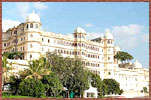 |
| |
|
Crystal Gallery - It is situated in the Fateh Prakash Palace is a breath taking collection of crystals. Maharana Sajjan Singh mainly ordered these crystals from F & C Osler England. But he could not see the crystals because of his untimely death. The crystal item includes tables, sofa sets, dinning table, dressers, fountains and even beds besides a whole array of washing bowls, decanters and perfume bottles.
|
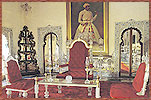 |
| |
|
Jag Mandir - This is the other island palace in Lake Pichola, which was constructed by Maharana Karan Singh as a hideout for Prince Khurram the estranged son of Emperor Jehangir the implacable foe of the Maharana. The reason for the aid was that the prince was the son of a Rajput mother. It is also said that Shah Jahan [prince Khurram] derived some of these ideas for the Taj Mahal from this palace when he stayed there in 1623-24. The island has some striking carving including a row of elephants that looks as though they are guarding the island. The exquisitely carved chhatri in grey and blue stone is another example. |
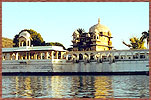 |
| |
|
Jagdesh Temple - Built by Maharana Jagat Singh I in 1651 the temple enshrines a black stone image of Lard Vishnu. There is a brass image of Garuda the Lord bird carrier. The exterior and the plinth are covered with base relief of alligators; elephants, horsemen and celestial musicians rise in tiers. Chanting, bells and music can be heard throughout the day. It is the largest and most splendid temple of Udaipur. |
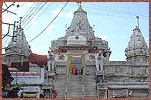 |
| |
|
Saheliyon ki Bari - This small ornamental garden was a popular relaxing spot where royal ladies came for a stroll and hence the name. The garden has many fountains in its four delightful pools, chiselled kiosks and marble elephants.On the eve of his departure from Mewar, Col.Tod had shifted to it so as to have some needed solitude. Much later, a thoughtful had located a library in it !
|
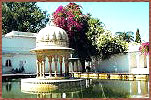 |
| |
|
Sajjangarh - The Monsoon Palace - Sajjangarh Wildlife Sanctuary is situated 5kms in the West of tourist city Udaipur, which surrounds the Sajjangarh Palace overlooking Udaipur City. From the palace, one can have a magnificent view of lakes of Udaipur and Aravalli hill ranges. The view of Sunrise and Sunset attracts every visitor atop of Bansdara hill.
Safari Park was created and wild animals like Chital, Sambar, Wild Boar, and Blue Bull were reintroduced. Animals like Panther, Hyena, Hare and Jackal has reappeared apart from variety of reptiles and birds. The wall extended further and now the entire hillock has been fenced, improving the vegetal cover of the sanctuary area. |
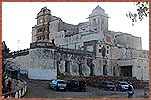 |
| |
|
Shilp Gram - The Craft Village - Literally meaning a "Craftsmen's Village" is a living ethnographic museum depicting the enormous diversities in craft, art & culture between various Indian states, but the exquisite terracotta work mainly in dark red and dark brown sand material along with the wooden carvings are the forte of this ethnic village . Shilpgram comprises 26 huts set in 70 acres of natural surroundings at the foot of the Aravali Hills.A colourful craft festival during winter seasons to the whole set up induces viatanity and zeal.
|
 |
| |
|
Fateh Sagar Lake -This delightful lake, bordered by hills and woodland was constructed by Maharana jai Singh to the north of Lake Pichola. It is an artificial lake dug up in 1678, reconstructed by Maharana Fateh Singh A canal links the two, via Swaroop Sagar and Rang Sagar Lakes. The beautiful Nehru Island as well as an islet bearing a solar observatory rises from the lake.
|
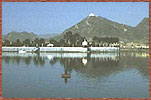 |
| |
|
Ghangaur Ghat - Bagore ki Haveli - This is a very congenial old building built right on the waterfront of Lake Pichola at Gangori Ghat. Amir Chand Badwa, the Prime Minister of Mewar built it in the eighteenth century. The palace has over hundred rooms and some very interesting display of costumes and modern art. The glass and mirror in the interiors of the Haveli delicate work and well preserved too. It also preserves a fine example of Mewar Painting on the walls of Queen's Chamber. The two peacocks made from small pieces of colored glasses are fine examples of glasswork. After the death Badwa the building became the property of Mewar State.
|
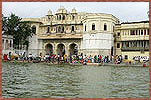 |
| |
|
The Vintage Car Collection -The collection within the grounds of the Garden Hotel comprises a variety of classic and interestingly rare transportation vehicles; some stately and vintage like Cadalec, Chevalate, Morais etc., while the others are sleek and fast .The Maharanas of Udaipur once possessed and used these regal splendours of automobiles as their luxuries but most of the other models are gradually being added to the collection ,since it provides a unique aristocratic safari for the exclusive guests.
|
|
| |
|
Ranakpur Jain Temples - The famous Ranakpur temples are just 50 kilometers from Kumbhalgarh by the scenic route through Vanpura and Saira. Begun in 1438 by Rana Kumbha, Ranakpur became a strangely tranquil meditation center in a frequently war ravaged land. It also became a magnificent sculpture museum to which wealthy Jain merchants and ministers kept adding shrines and statues. The central Chaumukha Temple is dedicated to the venerated Tirthankara Adinath. With its 29 halls and 1,444 distinctly different carved pillars, this is an astounding monument. Two temples dedicated to the Jain saints, Parasnath and Neminath have beautiful erotic carvings very similar to those which have made Khajuraho famous. And truly worth visiting is the much earlier, probably 6th century, Sun Temple close by, which has polygonal walls richly embellished with warriors, horses, and booted solar deities driving splendid chariots.Ranakpur is located 98 Km from Udaipur, named after Rana Kumbha, is one of the five main holy places of the Jains.
Its 500 years old temples are unique in their style & design, with no other place in Rajasthan having the same ambience and setting as that of Ranakpur.The most famous is the Chaumukha Temple sprawling over 48,000 sq.ft with 29 halls, 80 domes & 1,444 distinctively carved pillars.
Another temple worth visiting is the Sun Temple having polygonal walls with impressive carvings of warriors, horses & splendid chariots. |
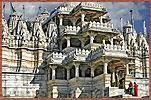 |
| |
|
Kumbhalgarh - is a stunning fortress built by Rana Kumbha in 15th century. The fort has perimeter walls that extend 36 kilometres in length. Claimed to be the longest in the world after "The Great Wall of China". Over 360 temples are within the fort. 300 ancient Jain and the rest Hindu. The vista from the palace top typically extends tens of kilometers into the Aravalli Range. It is located in the western part of Rajasthan in the Rajsamand District. It just 85 kms Udaipur. Today, precisely because it is within easy reach of Udaipur, Jodhpur, Ajmer, and Pushkar-yet off the well trodden tourist routes-Kumbhalgarh is an attractive destination.
The Kumbhalgarh Wildlife Sanctuary surrounds the fortress, covering an area of 578 km². The sanctuary extends across the Aravalli Range, covering parts of Rajsamand, Udaipur, and Pali districts, ranging from 500 to 1300 meters elevation. |
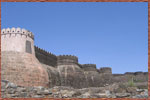 |
| |
|
Eklingji (22Km.)
The temple is situated 20km from Udaipur Eklingji is famous for its 108 temples complex. Built on a shore of a small lake surrounded by hills it is also known as Kailashpuri or the abode of Shiva.
It was built by Bappa Rawal on the side of 72 roomed jain temple which had a four faced idol of Adinathji , the first Jain saint.
First built in 728AD , the main temple is made in white marble. Made of black marble , the four faced image of Mahadev (an icon of Lord Shiva) is worshipped as Eklingji. |
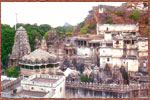 |
| |
|
Haldighati (40Km.)
The scene of the famous battle of 1576 AD fought between Rana Pratap, the heroic son of Udai Singh and the massive forces of the Mughal Emperor Akbar. A beautiful 'Chhatri' with white marble columns, dedicated to Rana Pratap stands here. |
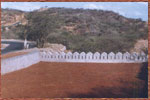 |
| |
|
Jaisamand (48Km.)
Jaisamand Sanctuary is situated 50-km south of Udaipur, the picturesque 'City of Lakes', succulent valleys and hills. It is on the bank of Jaisamand Lake, the second largest artificial Lake in Asia.
|
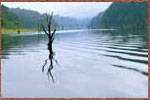 |
| |
|
Banswara
Banswara can be best described as the native place of the Bhils who form 39% of the tribal population of India. Banswara either got its name from bans or bamboo trees (Dendorocalamus stricus) which once grew in abundance here, or from a Bhil chieftain named Bansna. This Bhil chief was killed by Maharawal Jagmal Singh in the battle over the possession of the region. But Jagmal was quite impressed by Bansna’s bravery, and true to his generous nature he named the place after his rival. Banswara is presently known as the City of Hundred Islands due to the river Mahi, which borders the district and surrounds a number of islands. The Mahi river, revered by the locals, separates the Banswara and Dungarpur districts into two distinct regions. Banswara lies on the southeast of Rajasthan and is bounded by Udaipur in the west, Chittaurgarh in the north and the states of Madhya Pradesh and Gujarat in the east and the south respectively.
|
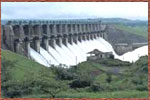 |
| |
|
WHERE TO EAT
There are so many good restaurants in Udaipur, suitable for all pockets. Our recommended must visit restaurants are Ambrahi, Sunset & the GalleryRestaurant at Fateh Prakash.
WHERE TO STAY
Udaipur has lot of choices when it comes accommodation. You can find here hotels from budget class to seven star resort.
|
| |
|
| |
|
| TOP |
|
| |
|
|


